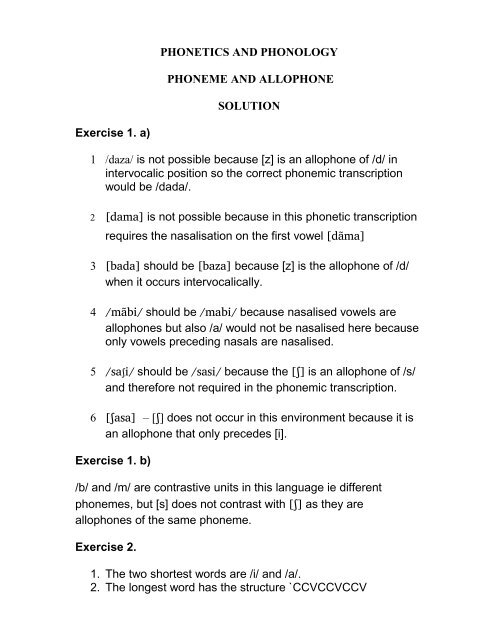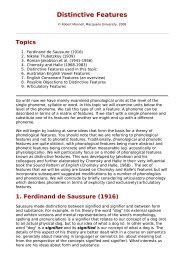PHONETICS AND PHONOLOGY PHONEME AND ALLOPHONE ...
PHONETICS AND PHONOLOGY PHONEME AND ALLOPHONE ...
PHONETICS AND PHONOLOGY PHONEME AND ALLOPHONE ...
Create successful ePaper yourself
Turn your PDF publications into a flip-book with our unique Google optimized e-Paper software.
Exercise 1. a)<br />
<strong>PHONETICS</strong> <strong>AND</strong> <strong>PHONOLOGY</strong><br />
<strong>PHONEME</strong> <strong>AND</strong> <strong>ALLOPHONE</strong><br />
SOLUTION<br />
1 /daza/ is not possible because [z] is an allophone of /d/ in<br />
intervocalic position so the correct phonemic transcription<br />
would be /dada/.<br />
2 [dama] is not possible because in this phonetic transcription<br />
requires the nasalisation on the first vowel [ ma]<br />
3 [bada] should be [baza] because [z] is the allophone of /d/<br />
when it occurs intervocalically.<br />
4 bi/ should be /mabi/ because nasalised vowels are<br />
allophones but also /a/ would not be nasalised here because<br />
only vowels preceding nasals are nasalised.<br />
5 /saʃi/ should be /sasi/ because the [ʃ] is an allophone of /s/<br />
and therefore not required in the phonemic transcription.<br />
6 [ʃasa] – [ʃ] does not occur in this environment because it is<br />
an allophone that only precedes [i].<br />
Exercise 1. b)<br />
/b/ and /m/ are contrastive units in this language ie different<br />
phonemes, but [s] does not contrast with [ʃ] as they are<br />
allophones of the same phoneme.<br />
Exercise 2.<br />
1. The two shortest words are /i/ and /a/.<br />
2. The longest word has the structure `CCVCCVCCV
3. Examples of two syllable words<br />
V`V /ia/ [i'a]<br />
V`V /ai/ [a' i]<br />
V`CV /ipa/ [i'pa]<br />
CV`V /pia/ [fi'a]<br />
V`CCV /ipni/ [i'pni]<br />
`CCVV /pnai/ ['pnai]<br />
CV`CV /pani/ [fa'ni]<br />
`CCVCV /pnani/ ['pnani]<br />
CV`CCV /nipna/ [ni'pna]<br />
`CCVCCV /pnipna/ ['pnifma]<br />
iii. You could use the fact that there are no minimal pairs and<br />
that these sounds only occur in complementary distribution.<br />
You could ask a speaker of the language to write down a word<br />
that contains a /f/ and if the writing system of the language is<br />
based on phonemic principles they would probably use a “p” for<br />
such sounds.<br />
You could demonstrate that speakers of this language have<br />
difficulty differentiating between the two sounds in minimal pairs<br />
e.g. cheap/chief.<br />
Exercise 3.<br />
/meli kalikimaka/<br />
i. There are no consonant clusters in this language so vowels<br />
will be inserted between adjacent consonants. As syllables<br />
always end in vowels there will be no word that ends in a<br />
consonant so again a vowel will be inserted.<br />
Vowels and consonants that are not present in the language will<br />
be substituted with those that are most similar eg /r/ -> /l/, /s/ -><br />
/k/ from the phonemic inventory of the language.<br />
ii. Hawaiian /p/ is used for English /p, b, f/
iii. Consonant clusters are either simplified to a single<br />
consonant eg “story” -> /kole/ or a vowel is inserted between the<br />
two elements.<br />
iv. /pal/ = /fl/, /ao/ = / {O/, /a/ = schwa<br />
v. / fo:ls/ -> /polaki/, /fli:t/ -> /paliki<br />
Exercise 4.<br />
/s/ occurs after [- voice] except sibilants and affricates<br />
/z/ occurs after [+voice] except sibilants and affricates<br />
/əz/ occurs after sibilants and affricates<br />
Exercise 5.<br />
/lɑr/ occurs when the stem contains a [+back] vowel<br />
/ler/ occurs when the stem contains a [-back] vowel

















